

Software libraries. IntercepTTY. Pi4J. The following example demonstrates how to transmit and receive data using the Raspberry Pi serial port.
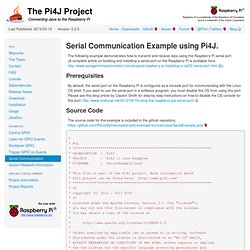
(A complete article on building and installing a serial port on the Raspberry Pi is available here: Prerequisites By default, the serial port on the Raspberry Pi is configured as a console port for communicating with the Linux OS shell. If you want to use the serial port in a software program, you must disable the OS from using this port.
Please see this blog article by Clayton Smith for step-by-step instructions on how to disable the OS console for this port: Source Code. ArduPi. Article Index Go to Index1.

The Shield. 8 Digital pins.Socket for wireless modules.RX/TX pins.i2C pins (SDA, SCL).SPI pins (SCK, MISO, MOSI, CS). Can be used also as GPIO.8 channel analog to digital converter.Switch to enable external power supply. WiringPi. Update: 14th May, 2013 wiringPi version 2 has been released and now has its own website ( to look after it.

Most of the documentation on the projects site has been copied over to it the new site, but there may still be 1 or 2 pages that are still missing. I’d encourage you to use the new site if possible where there will be a forum and wiki (when I get time to implement them!) WiringPi is an Arduino wiring-like library written in C and released under the GNU LGPLv3 license which is usable from C and C++ and many other languages with suitable wrappers (See below) You may be familiar with the Arduino… Briefly; Arduino is really two things; one is a hardware platform, the other software, and part of the software is a package called Wiring. The Raspberry Pi has a 26-pin General Purpose Input/Output (GPIO) connector and this carries a set of signals and buses.
NFC Tools - libnfc. Fundamentals of Mapping. Surveying for Mapping — Section 2, Surveying Methods Contents Surveying Methods Triangulation In the past it was difficult to accurately measure very long distances, but it was possible to accurately measure the angles between points many kilometres apart, limited only by being able to see the distant beacon.
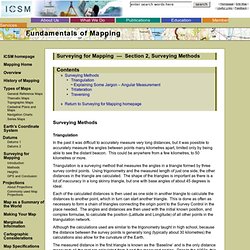
This could be anywhere from a few kilometres, to 50 kilometres or more. Triangulation and Trilateration Difference. These two illustations are from the field of surveying but they should still apply.

As Martin has said, in triangulation, you work with angles as illustrated in the following figure. The positions of the points of interest are computed based on measured angles and two know points. From those angles, the distances are computed which are in turn used to calculate coordinates for the target points. Bluetooth tracking. Bluetooth Indoor Positioning MSc Project. Bluetooth Triangulation Project Slides. A Similar MSC Thesis Post. Hi AaronKh, thanks for posting and including lots of links.
To really get down to brass tacks here, let me just say I too have seen many posts and received several personal emails asking about using RFID for positioning. The bottom line here is that RFID is an identification technology, not a positioning or position tracking technology. The association of RFID to "tracking" applications, particularly personal privacy invasion types of trackin has run rampant. The reality is, RFID is not suitable for positioning. Period. That being said, your best bet in building a triangulation system for a fixed area (10m x 10m x 10m 3D space), your best bet is to either use 3 readers fixed to the roof and adjacent walls: This image shows a reader fixed to the center of the roof, and two readers fixed to adjacent walls. Comments on RSSI and localisation. Rssi and Rfid. Hacking cheap RFID readers.
RFID readers on prototype supply places are expensive.
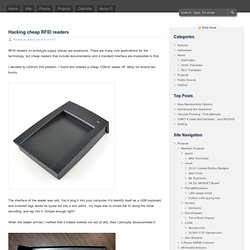
There are many cool applications for the technology, but cheap readers that include documentation and a standard interface are impossible to find. I decided to confront this problem. I found and ordered a cheap 125kHz reader off eBay for around ten bucks. The interface of the reader was usb. You’d plug it into your computer, it’d identify itself as a USB keyboard, and scanned tags would be typed out into a text editor. my hope was to locate the IC doing the initial decoding, and tap into it.
Hacked Door Open Remote with RedBee RFID and Raspberry Pi. On 2 Fridays ago, we had a "hackathon" at work where we stayed back and worked on personal hacks/projects.

The entry door to our office is controlled by a 4-number code. We have a remote control to open (unlock) it when someone rings the bell. PiDoorMan. Introduction The premise of proximity card access control is actually very simple: present a card to a readerdoor unlocks The actual mechanics are slightly more complex: proximity card reader sends out radio wavesinduces electric current in wire coils contained inside the cardpowers a microchip transmitter inside the cardreader picks up datadata transmitted down 2 wires as a series of electrical pulsesinterpreted by computercompared with allowed cardsif recognised a relay switches to unlock the door Passive RFID cards work in this way, whereas active RFID cards work slightly differently, in that they actually send out the number using battery power.
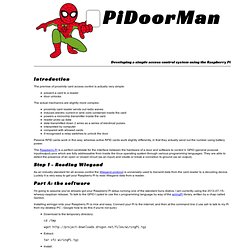
DoorBot/Locks - DoESWiki. Live System There is a system currently live built on Raspberry Pi, this is not the final design but is enough to keep us going.
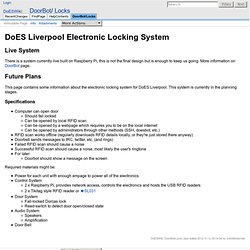
More information on DoorBot page. Future Plans. A Linux-Based RFID Thing Finder. July 19th, 2012 Sometimes I have things nicely organized. Power adapters for radios in one drawer, for cameras in the next. And sometimes… not so much. Sometimes I’m not sure if things are in the basement or the attic. It seems like technology should be able to help solve this problem, but as far as I can tell, no such solution exists yet.
So I’m planning to build one. Here’s my general idea. RFID Reader Localization Using Passive RFID Tags. Active RFID trilateration for indoor positioning. Alternative location methods for absolute positioning in areas where no GNSS position determination is possible due to obstruction of the satellite signals are needed in mobile positioning. Active RFID (Radio Frequency Identification) can be used also for position determination, although the system was not only developed for positioning and tracking but mainly for identification of objects. RFID Card Reader USB - $42.99. Raspberry Pi RFID Reader with Java and Pi4J.
This article explains how I am reading RFID tags with Java on a Raspberry Pi for my Shed-Door-Pi project. It could also be used as an insight into opening and reading from a serial port using Pi4j. For this first part, I will be demonstrating how to open the COM port and receive RFID key data from the reader. The second article will go into detail regarding parsing the data received and using it to determine whether a known RFID key has been scanned. I am making the assumption that the reader is able to compile and run Java applications on their Raspberry Pi, with the Pi4j libraries.
For more relevant information about this, please see the Pi4j Serial Communication example, Reading RFID With Raspberry Pi. A parallax RFID Reader via IntercepTTY. Hey all! The following is my first, and definitely not last, project with the RasPi. I encourage you to read this, BUT I will be posting a TL;DR video (I did my recording last night only to realize I had the mode on 3.1 MP ....-_- on my HD Camera). I hope you'll enjoy! #Background===========So I've always have nerded it up, but now I finally get to merge projects.
Passive RFID Project with PI. RFID 125 kHz shield for Raspberry Pi - 74 euro. RFID 125 kHz shield for Raspberry Pi tutorial. Contents: Introduction NOTE: All the code examples in this tutorial use the arduPi library. You can see the documentation and download the library here. Steps Index Steps Index: RFID 13,56 Mhz shield for Raspberry Pi - 90 euro. PN532 NFC/RFID controller breakout board - $39. The PN532 is the most popular NFC chip, and is what is embedded in pretty much every phone or device that does NFC. It can pretty much do it all, such as read and write to tags and cards, communicate with phones (say for payment processing), and 'act' like a NFC tag. Tutorial - Adafruit NFC/RFID on Raspberry Pi. Pi Cobbler Breakout Kit for Raspberry Pi - $7.95. Active RFID tags.